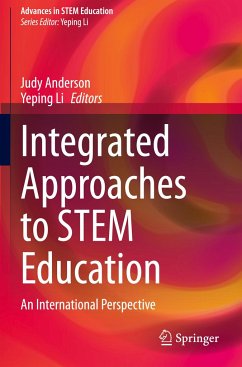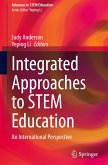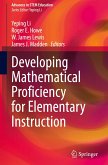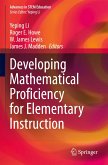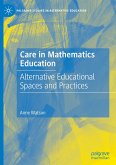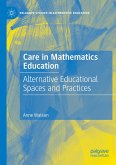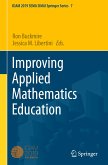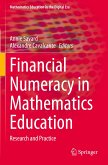Integrated Approaches to STEM Education
An International Perspective
Herausgegeben:Anderson, Judy; Li, Yeping
Integrated Approaches to STEM Education
An International Perspective
Herausgegeben:Anderson, Judy; Li, Yeping
- Broschiertes Buch
- Merkliste
- Auf die Merkliste
- Bewerten Bewerten
- Teilen
- Produkt teilen
- Produkterinnerung
- Produkterinnerung
This book provides a platform for international scholars to share evidence for effective practices in integrated STEM education and contributes to the theoretical and practical knowledge gained from the diversity of approaches.
Many publications on STEM education focus on one or two of the separate STEM disciplines without considering the potential for delivering STEM curriculum as an integrated approach.This publication analyzes the efficacy of an integrated STEM curriculum and instruction, providing evidence to examine and support various integrations. The volume focuses on the problems…mehr
Andere Kunden interessierten sich auch für
![Integrated Approaches to STEM Education Integrated Approaches to STEM Education]() Integrated Approaches to STEM Education119,99 €
Integrated Approaches to STEM Education119,99 €![Developing Mathematical Proficiency for Elementary Instruction Developing Mathematical Proficiency for Elementary Instruction]() Developing Mathematical Proficiency for Elementary Instruction104,99 €
Developing Mathematical Proficiency for Elementary Instruction104,99 €![Developing Mathematical Proficiency for Elementary Instruction Developing Mathematical Proficiency for Elementary Instruction]() Developing Mathematical Proficiency for Elementary Instruction100,99 €
Developing Mathematical Proficiency for Elementary Instruction100,99 €![Care in Mathematics Education Care in Mathematics Education]() Anne WatsonCare in Mathematics Education97,99 €
Anne WatsonCare in Mathematics Education97,99 €![Care in Mathematics Education Care in Mathematics Education]() Anne WatsonCare in Mathematics Education139,09 €
Anne WatsonCare in Mathematics Education139,09 €![Improving Applied Mathematics Education Improving Applied Mathematics Education]() Improving Applied Mathematics Education75,99 €
Improving Applied Mathematics Education75,99 €![Financial Numeracy in Mathematics Education Financial Numeracy in Mathematics Education]() Financial Numeracy in Mathematics Education123,99 €
Financial Numeracy in Mathematics Education123,99 €-
-
-
This book provides a platform for international scholars to share evidence for effective practices in integrated STEM education and contributes to the theoretical and practical knowledge gained from the diversity of approaches.
Many publications on STEM education focus on one or two of the separate STEM disciplines without considering the potential for delivering STEM curriculum as an integrated approach.This publication analyzes the efficacy of an integrated STEM curriculum and instruction, providing evidence to examine and support various integrations. The volume focuses on the problems seen by academics working in the fields of science, technology, engineering and mathematics (STEM) and provides valuable, high quality research outcomes and a set of valued practices which have demonstrated their use and viability to improve the quality of integrated STEM education.
Many publications on STEM education focus on one or two of the separate STEM disciplines without considering the potential for delivering STEM curriculum as an integrated approach.This publication analyzes the efficacy of an integrated STEM curriculum and instruction, providing evidence to examine and support various integrations. The volume focuses on the problems seen by academics working in the fields of science, technology, engineering and mathematics (STEM) and provides valuable, high quality research outcomes and a set of valued practices which have demonstrated their use and viability to improve the quality of integrated STEM education.
Produktdetails
- Produktdetails
- Advances in STEM Education
- Verlag: Springer / Springer International Publishing / Springer, Berlin
- Artikelnr. des Verlages: 978-3-030-52231-5
- 1st edition 2020
- Seitenzahl: 592
- Erscheinungstermin: 24. Dezember 2021
- Englisch
- Abmessung: 235mm x 155mm x 32mm
- Gewicht: 885g
- ISBN-13: 9783030522315
- ISBN-10: 3030522318
- Artikelnr.: 63049432
- Herstellerkennzeichnung Die Herstellerinformationen sind derzeit nicht verfügbar.
- Advances in STEM Education
- Verlag: Springer / Springer International Publishing / Springer, Berlin
- Artikelnr. des Verlages: 978-3-030-52231-5
- 1st edition 2020
- Seitenzahl: 592
- Erscheinungstermin: 24. Dezember 2021
- Englisch
- Abmessung: 235mm x 155mm x 32mm
- Gewicht: 885g
- ISBN-13: 9783030522315
- ISBN-10: 3030522318
- Artikelnr.: 63049432
- Herstellerkennzeichnung Die Herstellerinformationen sind derzeit nicht verfügbar.
Dr Judy Anderson is an Associate Professor in Mathematics Education at the Sydney School of Education and Social Work, the University of Sydney, Australia with research interests in mathematics education, motivation and engagement, and STEM professional learning. At the University of Sydney, she has held the position of Director of the STEM Teacher Enrichment Academy for the past six years. This professional development program for primary and secondary school teachers has reached nearly 1250 teachers in more than 220 schools and is supported by a team of 12 academic staff, a postdoctoral research fellow and a project manager. Judy has published widely with more 70 publications since 2009 in international, and national journals and conference proceedings. She is currently the Associate Editor of Curriculum Perspectives, an international Springer journal, and is a member of the editorial board of the Springer publication Mathematics Teacher Education and Development. She is currently the Secretary of the International Group of the Psychology of Mathematics Education (IGPME). Dr. Yeping Li is a Full Professor at the Department of Teaching, Learning, and Culture at Texas A&M University, USA. His research interests include mathematics education, STEM education, and teacher education. He is the founding editor-in-chief of the International Journal of STEM Education and Journal for STEM Education Research, both published by Springer, and is also the editor of several monograph series including, Advances in STEM Education also published by Springer. In addition to publishing over 15 books and special journal issues in recent years, he has published more than 100 articles in topic areas that he is interested in. He has also organized and chaired many group sessions at various national and international professional conferences, such as International Congress on Mathematical Education -10 (ICME-10) (2004), ICME-11 (2008), ICME-12 (2012), and American Educational Research Association (AERA). He received his Ph.D. in Cognitive Studies in Education from the University of Pittsburgh, USA.
1. Introduction; Judy Anderson and Yeping Li.- Section 1 Approaches to STEM Integration.- 2. STEM Education for the 21st Century; Russell Tytler.- 3. Facilitating STEM Integration through Design; Lyn English.- 4. A Review of Conceptions of Mathematics in Integrated STEM Education; Erin E. Baldinger, Sue Staats, Lesa M. Covington-Clarkson, Elena Gullickson, Fawnda Norman, and Bismark Akoto.- 5. What is the Role of Statistics in Integrating STEM Education? Jane Watson, Noleine Fitzallen, and Helen Chick.- 6. STEM and Numeracy in the Australian Curriculum; Anne Bennison and Vince Geiger.- 7. Investigating the epistemic nature of STEM: Analysis of curriculum documents from the USA using the Family Resemblance Approach; Wonyong Park, Jen-Yi Wu and Sibel Erduran.- 8. Using a proposed Integrated STEM Framework for Designing Lessons in the Singaporean Context; Tang Wee Teo, Aik-Ling Tan, & Kuang Wen Chan.- 9. Approaches to effecting an integrated STEM education in Southern Africa; Judah Makonye and Reuben Dlamini.- Section 2 Designing Integrated STEM Approaches for Students.- 10. Connecting mathematics and science in a US elementary classroom: Investigating computational thinking and the particle nature of matter through project based learning; Emily Miller, Samuel Severance and Joe Krajcik.- 11. Developing US elementary students' STEM practices and concepts in an after school integrated STEM project; Sasha Wang, Steve Swanson, Yuhui Ching, Youngkyun Baek, Dazhi Yang, and Bhaskar Chittoori.- 12. Student STEM beliefs in the UK: how they shift and are shaped by transdisciplinary projects; Karen Skilling.- 13. Climate change and students' critical competences: A Norwegian study; Lisa Steffensen.- 14. Incorporating Mathematical Thinking into High School STEM Physics - A CaseStudy in the USA; Israel Touitou and Joe Krajcik.- 15. The Next Generation of STEM Education in Asia: Collaborative curriculum design in Taiwan, Thailand and Vietnam; Chun-Yen Chang and Pei-Ling Lin.- 16. STEM skill assessment of student learning: An application for Adaptive Comparative Judgment; Scott R. Bartholomew and P. John Williams.- Section 3 Implementing Integrated STEM Approaches in Preservice Teacher Education.- 17. Missing Coherence in STEM Education: Creating Design Based Pedagogical Content Knowledge (DPCK) in Turkish Preservice education; Ibrahim Delan, Consuelo Morales and Joe Krajcik.- 18. Promoting a learning scenario for an integrated approach to STEM: prospective teachers' perspectives in Portugal; Ana Henriques, Hélia Oliveira, and Mónica Baptista.- 19. Increasing Pre-Service Teachers' Engagement with STEM Learning in Australia; Duncan Symons and Joanne Blannin.- Section 4 Implementing Integrated STEM Approaches in Teacher Professional Development.- 20. Designing and evaluating an integrated STEM professional development program for secondary and primary school teachers in Australia; Judy Anderson and Debbie Tully.- 21. Argumentation in primary grades STEM instruction: Examining teachers' beliefs and practices in the USA; AnnaMarie Conner, Barbara Crawford, Timothy Foutz, Roger B. Hill, David F. Jackson, ChanMin Kim, and Sidney A. Thompson.- 22. Integrated STEM Education in Virginia, USA: CodeVirginia K-5 Coaches Academy; Anita Crowder, Rebecca Dovi and David Naff.- 23. Promoting Integrated STEM Tasks in the Framework of Teachers' Professional Development in Portugal; Maria Cristina Costa, António Domingos and Vítor Teodoro.- 24. Integrated STEM in Australian Public Schools: Opening up Possibilities for Classrooms and Effective Teacher Professional Development; Jane Hunter.- Section 5 Future Directions.- 25. If Integrated STEM Education is the Solution, how do we get there? Author to be identified.
1. Introduction; Judy Anderson and Yeping Li.- Section 1 Approaches to STEM Integration.- 2. STEM Education for the 21st Century; Russell Tytler.- 3. Facilitating STEM Integration through Design; Lyn English.- 4. A Review of Conceptions of Mathematics in Integrated STEM Education; Erin E. Baldinger, Sue Staats, Lesa M. Covington-Clarkson, Elena Gullickson, Fawnda Norman, and Bismark Akoto.- 5. What is the Role of Statistics in Integrating STEM Education? Jane Watson, Noleine Fitzallen, and Helen Chick.- 6. STEM and Numeracy in the Australian Curriculum; Anne Bennison and Vince Geiger.- 7. Investigating the epistemic nature of STEM: Analysis of curriculum documents from the USA using the Family Resemblance Approach; Wonyong Park, Jen-Yi Wu and Sibel Erduran.- 8. Using a proposed Integrated STEM Framework for Designing Lessons in the Singaporean Context; Tang Wee Teo, Aik-Ling Tan, & Kuang Wen Chan.- 9. Approaches to effecting an integrated STEM education in Southern Africa; Judah Makonye and Reuben Dlamini.- Section 2 Designing Integrated STEM Approaches for Students.- 10. Connecting mathematics and science in a US elementary classroom: Investigating computational thinking and the particle nature of matter through project based learning; Emily Miller, Samuel Severance and Joe Krajcik.- 11. Developing US elementary students' STEM practices and concepts in an after school integrated STEM project; Sasha Wang, Steve Swanson, Yuhui Ching, Youngkyun Baek, Dazhi Yang, and Bhaskar Chittoori.- 12. Student STEM beliefs in the UK: how they shift and are shaped by transdisciplinary projects; Karen Skilling.- 13. Climate change and students' critical competences: A Norwegian study; Lisa Steffensen.- 14. Incorporating Mathematical Thinking into High School STEM Physics - A CaseStudy in the USA; Israel Touitou and Joe Krajcik.- 15. The Next Generation of STEM Education in Asia: Collaborative curriculum design in Taiwan, Thailand and Vietnam; Chun-Yen Chang and Pei-Ling Lin.- 16. STEM skill assessment of student learning: An application for Adaptive Comparative Judgment; Scott R. Bartholomew and P. John Williams.- Section 3 Implementing Integrated STEM Approaches in Preservice Teacher Education.- 17. Missing Coherence in STEM Education: Creating Design Based Pedagogical Content Knowledge (DPCK) in Turkish Preservice education; Ibrahim Delan, Consuelo Morales and Joe Krajcik.- 18. Promoting a learning scenario for an integrated approach to STEM: prospective teachers' perspectives in Portugal; Ana Henriques, Hélia Oliveira, and Mónica Baptista.- 19. Increasing Pre-Service Teachers' Engagement with STEM Learning in Australia; Duncan Symons and Joanne Blannin.- Section 4 Implementing Integrated STEM Approaches in Teacher Professional Development.- 20. Designing and evaluating an integrated STEM professional development program for secondary and primary school teachers in Australia; Judy Anderson and Debbie Tully.- 21. Argumentation in primary grades STEM instruction: Examining teachers' beliefs and practices in the USA; AnnaMarie Conner, Barbara Crawford, Timothy Foutz, Roger B. Hill, David F. Jackson, ChanMin Kim, and Sidney A. Thompson.- 22. Integrated STEM Education in Virginia, USA: CodeVirginia K-5 Coaches Academy; Anita Crowder, Rebecca Dovi and David Naff.- 23. Promoting Integrated STEM Tasks in the Framework of Teachers' Professional Development in Portugal; Maria Cristina Costa, António Domingos and Vítor Teodoro.- 24. Integrated STEM in Australian Public Schools: Opening up Possibilities for Classrooms and Effective Teacher Professional Development; Jane Hunter.- Section 5 Future Directions.- 25. If Integrated STEM Education is the Solution, how do we get there? Author to be identified.
"Integrated Approaches to STEM Education: An International Perspective is a compendium of chapters ... . the editors and chapter authors paint an exciting and detailed picture of both what is possible and what is challenging about an Integrated Approaches to STEM Education." (Suzanne M. Wilson, Journal for STEM Education Research, Vol. 4, 2021)

